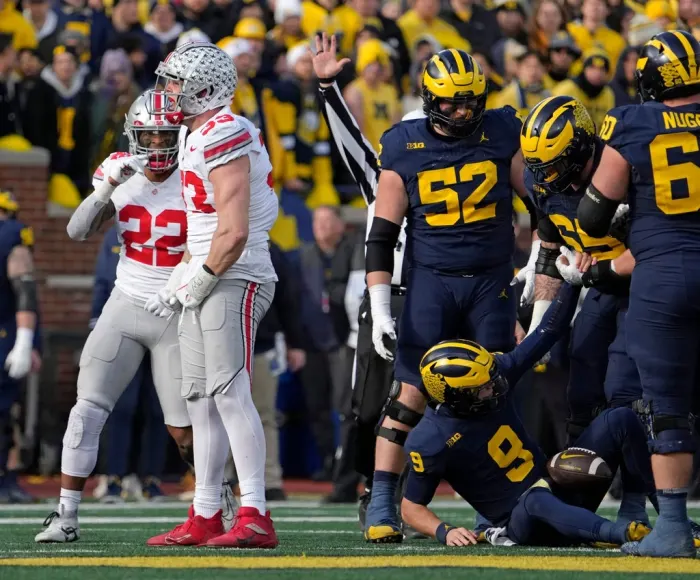The Ohio State Buckeyes and the Michigan Wolverines have long stood as two of college football’s most iconic programs, their rivalry steeped in history, animosity, and high-stakes competition. While their battles on the field have always captured national attention, their war off the field—specifically on the recruiting trail—has grown just as fierce. Now, with the spotlight turning to one of the nation’s top high school football prospects, the Buckeyes find themselves in a familiar situation: locked in a head-to-head battle with Michigan, and the outcome could help shape the trajectory of the Big Ten for years to come.
According to a well-placed recruiting insider, Ohio State will need to outbid Michigan—figuratively and perhaps even literally—in order to land this elite prospect. In the age of NIL deals and growing player autonomy, “outbidding” isn’t just a metaphor. With the NCAA’s evolving policies on player compensation and the rise of collective-driven opportunities, financial packages have become an undeniable part of modern recruiting strategy. While schools don’t directly pay players, the infrastructures surrounding them—from boosters to NIL collectives—have changed the game. For Ohio State to land this recruit, they must not only sell their tradition, development pipeline, and winning culture but also present the most compelling package in today’s recruiting ecosystem.
Ohio State has long prided itself on being a premier destination for top talent, consistently ranking among the top five in recruiting classes year after year. The program has produced first-round NFL Draft picks with machine-like consistency, developed Heisman candidates, and competed in multiple College Football Playoff appearances since the system’s inception. The Buckeyes have also built a reputation for player development, especially at high-profile positions like quarterback, wide receiver, and defensive end. These are all critical factors for high school players deciding where to spend the most important three or four years of their football lives.
Michigan, on the other hand, has surged in recent years under Jim Harbaugh and now Sherrone Moore, breaking Ohio State’s stronghold over the Big Ten with back-to-back wins in “The Game” and a national championship in the 2023 season. That success has changed the perception of Michigan in recruiting circles. Once seen as the second-tier Big Ten brand to Ohio State, Michigan now commands respect as a legitimate national powerhouse with NFL coaching acumen and a proven winning culture. Their ability to beat the Buckeyes on the field has added significant momentum on the trail, and they’ve started to flip recruits who, in earlier years, would have automatically leaned Scarlet and Gray.
What makes this recruiting battle particularly intense is not just the shared interest in the player but the position he plays and the implications of where he ultimately commits. If this top prospect is a quarterback, for example, it would mean a potential centerpiece of a future offense. For years, Ohio State has cultivated a quarterback-friendly system that has produced stars like Justin Fields, C.J. Stroud, and now eyes Kyle McCord and incoming talents to follow. Michigan, meanwhile, has begun shedding its past reputation of underwhelming quarterback play, with recent years showing more efficiency and better game management under center. Securing a high-profile quarterback would symbolize that the Wolverines are serious about offensive evolution.
If it’s a defensive end or cornerback, then the competition becomes just as heated. Both programs pride themselves on producing elite defenders. Michigan’s recent NFL draftees, including pass-rushers like Aidan Hutchinson, have boosted their defensive brand. Ohio State, too, has no shortage of names like Chase Young, Jeff Okudah, and Marshon Lattimore, which makes their pitch just as compelling. Defensive stars often want to play for programs that will maximize their exposure and accelerate their NFL paths, and both schools check that box in bold print.
What makes the recruiting tug-of-war even more intriguing is the personal relationships involved. Recruiting is about relationships as much as resources. The Buckeyes’ coaching staff has been relentless in pursuing the player, ensuring constant communication, in-person visits, and building trust with the family. Brian Hartline, widely regarded as one of the best recruiters in college football, has likely played a key role if the position is on offense. His work with wide receivers and his ability to identify and nurture talent has drawn national acclaim. If the recruit is a receiver, Hartline’s track record alone could be Ohio State’s most compelling card to play.
On the Michigan side, the staff has done a phenomenal job of building rapport not just with the player, but with his circle of influence. They’ve emphasized the academic component, culture of discipline, and the program’s physical identity. Michigan’s message has increasingly resonated with recruits who see value in development over hype. The Wolverines’ recent NFL Draft success, especially among offensive linemen and defensive players, bolsters that message. If the player in question is looking for a system that emphasizes toughness, development, and team-first mentality, Michigan’s pitch is more powerful than ever.
Behind the scenes, NIL negotiations are increasingly becoming the X-factor. No program can ignore the financial aspect of recruiting anymore. Players today are keenly aware of their marketability and value. For programs like Ohio State and Michigan, both of which have strong NIL infrastructures, it comes down to how convincingly they can project long-term value, brand association, and earning potential. This isn’t about throwing the largest dollar figure on the table, but demonstrating how the university and its affiliated NIL entities can build sustainable earning paths for players during and after college.
Ohio State is not one to be outmaneuvered on this front. With collectives like The Foundation working to support Buckeye athletes and a massive alumni and fan base that fuels endorsement opportunities, the Buckeyes can go toe-to-toe with any school in terms of NIL offerings. Michigan, meanwhile, has made great strides to catch up in the NIL arms race, ensuring their athletes are fairly compensated and marketable. The Wolverines’ response has been to emphasize structure and sustainability in NIL deals, promoting a team-focused approach that still rewards individual success.
Location and fit also play roles that can’t be overlooked. Columbus and Ann Arbor are only a few hours apart, but the environments are distinctly different. Ohio State offers a more urban experience with access to a larger metro area, professional networks, and corporate partnerships. Michigan offers a classic college town atmosphere, with a blend of academics and tradition that speaks to recruits who see college as more than just a path to the NFL. For recruits with strong academic leanings or families placing value on education, Michigan’s academic prestige might tip the scale. For others prioritizing a straight football path, Ohio State’s track record might weigh heavier.
Family influence can also become the silent tiebreaker. If the player’s family has strong ties to one of the schools or if a current or former teammate plays there, it can shape perceptions. Even weather, travel considerations, and fit with current players on the roster can tilt decisions in unexpected ways. That’s why both schools are pulling out all the stops, engaging not just the player but his entire support system in the process.
As this recruiting saga plays out, fans from both sides are watching every movement with bated breath. Social media adds another layer of complexity. Every Instagram post, cryptic tweet, or visit photo can set off a storm of speculation. Message boards explode with theories, and insiders drop breadcrumbs that keep the digital community in a constant state of vigilance. The player’s announcement—whenever it comes—will be a spectacle in itself. Whether it’s a commitment ceremony with hats on a table or a surprise drop on social media, the choice will make headlines.
For the Buckeyes, winning this battle would not just mean adding a blue-chip talent to their roster. It would signal that Ohio State remains the top recruiting force in the Midwest and can withstand Michigan’s resurgence. For Michigan, landing the player would represent another symbolic and tangible win over their bitter rivals. It would prove that their recruiting momentum is real, sustained, and no longer overshadowed by Ohio State’s historic dominance.
In the end, the recruitment of this top prospect is not just about one player. It’s about perception, momentum, and the ongoing struggle for supremacy between two of college football’s most storied programs. The outcome could echo for years, shaping depth charts, playoff hopes, and future recruiting classes. And while fans wait, debate, and refresh their feeds for updates, the only certainty is that both sides are leaving nothing on the table in pursuit of victory—because when Ohio State and Michigan compete, every inch matters, on the field and off.



